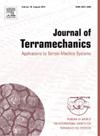Climbing loose surfaces with steep slopes using a small, lightweight push-rolling rover with minimal configuration
IF 3.7
3区 工程技术
Q3 ENGINEERING, ENVIRONMENTAL
引用次数: 0
Abstract
Owing to the payload limitations, some organizations are focusing on small, lightweight wheeled rovers for planetary exploration. Planetary and lunar surfaces feature weak soils and slopes that pose mobility challenges for wheeled rovers. Studies have shown that push–pull locomotion can improve climbing ability. Such rovers lock one pair of wheels relative to the ground while driving the other like an inchworm. Conventional rovers have large masses ranging from 10 to nearly 1,000 kg. However, some studies are now focusing on small rovers of masses from under 1 kg to 20 kg. For such rovers, traveling on granular surfaces with steep slopes and low slips remains an experimental challenge. This study develops a small, lightweight push-rolling rover and evaluates its ability to climb steep slopes. To meet size requirements, the rover uses a minimal configuration. Experiments to measure resistance and drawbar pull forces during push-rolling revealed that a lugged wheel and dynamic sinking behavior using an intentional slip increased the total thrust forces. Additionally, travel experiments showed that the developed rover, with its optimal configuration, demonstrated a high climbing ability on slopes greater than 30°.
使用一个小型的、轻量级的、配置最小的推推式漫游者爬上陡峭斜坡的松散表面
由于有效载荷的限制,一些组织将重点放在用于行星探测的小型、轻型轮式漫游者上。行星和月球表面的土壤和斜坡都很脆弱,这对轮式漫游者的机动性构成了挑战。研究表明,推拉运动可以提高攀爬能力。这种漫游者在像尺蠖一样驱动另一对轮子的同时,将一对轮子相对于地面锁住。传统火星车的质量从10公斤到近1000公斤不等。然而,一些研究现在集中在质量从1公斤到20公斤的小型探测器上。对于这样的漫游者来说,在陡坡和低滑动的颗粒状表面上行驶仍然是一个实验挑战。本研究开发了一种小型的、轻量级的推滚式漫游车,并评估了它爬陡坡的能力。为了满足尺寸要求,探测车采用了最小配置。通过测量推滚过程中的阻力和拉杆拉力的实验表明,拖轮和有意滑移的动态下沉行为增加了总推力。此外,运行实验表明,该月球车在最佳配置下,在大于30°的斜坡上表现出较高的爬坡能力。
本文章由计算机程序翻译,如有差异,请以英文原文为准。
求助全文
约1分钟内获得全文
求助全文
来源期刊

Journal of Terramechanics
工程技术-工程:环境
CiteScore
5.90
自引率
8.30%
发文量
33
审稿时长
15.3 weeks
期刊介绍:
The Journal of Terramechanics is primarily devoted to scientific articles concerned with research, design, and equipment utilization in the field of terramechanics.
The Journal of Terramechanics is the leading international journal serving the multidisciplinary global off-road vehicle and soil working machinery industries, and related user community, governmental agencies and universities.
The Journal of Terramechanics provides a forum for those involved in research, development, design, innovation, testing, application and utilization of off-road vehicles and soil working machinery, and their sub-systems and components. The Journal presents a cross-section of technical papers, reviews, comments and discussions, and serves as a medium for recording recent progress in the field.
 求助内容:
求助内容: 应助结果提醒方式:
应助结果提醒方式:


